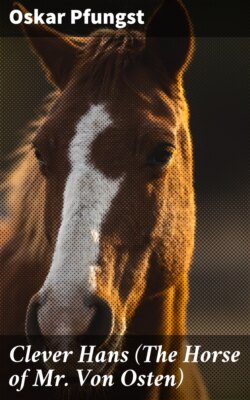Читать книгу Clever Hans (The Horse of Mr. Von Osten) - Oskar Pfungst - Страница 10
На сайте Литреса книга снята с продажи.
A. Experimental Conditions
ОглавлениеTable of Contents
The observations on the horse under ordinary conditions would have been quite insufficient for arriving at a decision as to the tenability of the several possible explanations. For this purpose experimentation with controlled conditions was necessary.
It was necessary, first, that the place in which the experiments were performed should be guarded against sources of error and interruptions. Several difficulties stood in the way of the removal of the horse to a more convenient place. Therefore, a large canvas tent was erected within the courtyard of Mr. von Osten. This afforded the necessary isolation without hindering the free movements of the horse. After the essential part of the experiment had been completed and the problem had been practically solved, experimentation was sometimes conducted in the open courtyard. A number of the experiments were also performed in the horse's stall.
The choice of proper persons to experiment with the horse required careful consideration. In so far as observations were to be made upon the questioner, Mr. von Osten was of course indispensable. But to obviate every objection he, as well as Mr. Schillings, had to be excluded from the greater part of the experiments, and other persons had to be selected who could learn to handle the horse. Now one would have thought that the horse would respond to any moderately efficient examiner. But as a matter of fact it was found that the horse would not react at all in the case of the greater number of persons. Again, in the case of others he would respond once or twice, but would then cease. All told, Hans responded more or less readily to forty persons, but it was only when he worked with Mr. von Osten or with Mr. Schillings, that his responses were at all dependable. For this reason I undertook to befriend the horse, and by happy chance it came to pass in a short time he responded as readily to my questions as to those of the two gentlemen. In a few of these experiments the Count zu Castell, Count R. von Matuschka and Mr. Schillings undertook the rôle of questioner. Where these are not mentioned in the results here published, I myself did the questioning.
With regard to the number of experiments and their performance, the following precautions were observed. A sufficiently large number of tests was made in each series in order to obviate the possibility of the contention that the horse's errors were due to chance. The conditions of experimentation were such that the further contention that he happened to be tired or otherwise indisposed, whenever the reactions seemed to be inadequate, could not be offered. The possibility of confusing the horse by means of unwonted conditions also had to be avoided. For this reason it was necessary to alternate the trial in which procedure was with the knowledge of the answer on the part of the questioner, with the trial in which the procedure was without such knowledge. Such precautions had hitherto been neglected, and therefore those negative results which had been occasionally obtained in single trials, could not claim objective validity, even though the persons making the tests were subjectively convinced.
The course of the experiments was determined by the nature of the problem itself. By means of a very simple test it was possible to discover whether or not Hans was able to think independently. He was confronted with problems in which the procedure was without knowledge of the answer on the part of the questioner. If under these conditions he could respond with the correct answer—which could be the result of a rational process only—then the conclusion that he could think independently, was warranted. The examination would be closed and Mr. von Osten would be justified in all he claimed for the horse. If, however, Hans should fail in this test, then the conclusion that he could think was by no means warranted, but rather the inference that he was dependent upon certain stimuli received from the questioner or the environment. Further investigation would be for the purpose of discovering the nature of these stimuli.
To ascertain by means of which sense organ or organs the horse might receive these necessary stimuli, the method of elimination was employed. We began by excluding visual stimuli by means of a pair of very large blinders. Should this investigation be without results, then we would proceed to test the sense of hearing. The elimination of auditory stimulations would be more difficult, because ear-caps or the closing of the passage by means of cotton would not give sufficient assurance that the sound-waves were being interrupted, even if the horse were docile enough to suffer these appliances. Thereupon would follow the testing of the sense of smell and of the skin-senses. And finally there might be involved another still unknown sense, such as seems to exist in the lower animal-forms. The reader therefore can readily see that the investigation might possibly have become very complex, and that the investigator had to be prepared for all of these possibilities.
The results of the experiments and the essential circumstances under which they were conducted, were in every case recorded immediately.
It goes without saying that in the final formulation of the results, all values—including those which were not consonant with the majority—were to be used.
